Guide to
Getting
A RTS
Grants
ELLEN LIBERATORI

2006 Ellen Liberatori
All rights reserved. Copyright under Berne Copyright Convention, Universal Copyright Convention, and Pan-American Copyright Convention. No part of this book may be reproduced, stored in a retrieval system, or transmitted in any form, or by any means, electronic, mechanical, photocopying, recording, or otherwise, without prior permission of the publisher.
10 09 08 07 06 5 4 3 2 1
Published by Allworth Press
An imprint of Allworth Communications, Inc.
10 East 23rd Street, New York, NY 10010
Cover design by Derek Bacchus
Interior design by Joan OConnor
Typography by Integra Software Services, Pondicherry, India
ISBN-13: 978-1-58115-456-6
ISBN-10: 1-58115-456-9
ISBN: 9781581158311
Library of Congress Cataloging-in-Publication Data
Liberatori, Ellen.
Guide to getting arts grants / Ellen Liberatori.
p. cm.
Includes bibliographical references and index.
1. ArtsUnited StatesFinance. 2. Arts fund raisingUnited
States. 3. Proposal writing for grantsUnited States. I. Title.
NX705.5.U6L53 2006
700.7973-dc22
2006013939
Printed in the United States of America
ACKNOWLEDGMENTS
Thanks to all the staff of Allworth Press, especially Tad Crawford and Nicole Potter-Talling, for the opportunity to write this book and for their helpful guidance and assistance in putting it together. Thank you to Monica Lugo and Nana Greller for making the task seamless in project management and publicity.
Thank you to my colleagues and associates for their great support and permission to highlight their work:
 Anita Pampusch, John Archabal, and Martha Lee at the Bush Foundation
Anita Pampusch, John Archabal, and Martha Lee at the Bush Foundation
 Neal Cuthbert at the McKnight Foundation
Neal Cuthbert at the McKnight Foundation
 Cynthia Gehrig at the Jerome Foundation
Cynthia Gehrig at the Jerome Foundation
 Bill King at the Council of Foundations
Bill King at the Council of Foundations
 David Gergen, who encouraged me to flee my nest in St. Croix. I draw strength from your kind words
David Gergen, who encouraged me to flee my nest in St. Croix. I draw strength from your kind words
 The Dyson Foundation for the use of its sample grant agreement
The Dyson Foundation for the use of its sample grant agreement
 The board of directors, staff, teachers, and students at the West Bank School of Music
The board of directors, staff, teachers, and students at the West Bank School of Music
 The staff at Open U/Learning Annex
The staff at Open U/Learning Annex
A very special thank you to Jon Harrison at the University of Michigan, who has permitted the use of the great resources and Web links that will help artists and nonprofit organizations in seeking support.
I extend my most heartfelt thanks to my fellow artists, teachers, and mentors for their support throughout a very long journey. Thank you for allowing me to share your successes as you continue to inspire: Bill Banfield, Milo Fine, Clint Hoover, John Minczeski, Carei Thomas, and Barb Tilsen.
To the many grantseekers, clients, and colleagues who are often lost along the way, I thank you for sharing, dreaming, risking, and learning with me.
To my dearest friends and family, here and abroad, who have never wavered in the belief of all my crazy dreams, your continued support has made all the difference.
To Aida Ayoub, whose courage and will in the face of great adversity inspired me to send in this manuscript.
To Karen and Arnold Kustritz, who gave so much to make this happen; without you and the Birdhouse, I would have been lost.
To Mary Olympia, who has been alongside me every step of the way.
And to Marwan El Dewey and Angela Cressaty, whose support of this writers life helped make it possible.
INTRODUCTION
I listen to [a] concert in which so many parts are wanting.
HENRY DAVID THOREAU
This is how it feels to live the life of an artist: Many ideas, projects, brainstorms, and muses coming at us at once, a barrage of details to manage. And typically, the biggest challenge is finding the time to be creative. We have so many daily responsibilities that our creative passions take a backseat. And unless you are an established artist, the time you take for your creative pursuit may conflict with time you already spend on supporting yourself in other ways. This time and space equates to money, your livelihood, and financial support. The typical scenario is to juggle day work while you do your art. Often you have special projects and need concentrated time without the distractions and pitfalls of your job. You desperately need to get to that creative place that helps you produce something wonderful. Yet, without the rich uncle, where do you turn?
There is the world of philanthropy and grants. Many of us have heard of it, but few have clues concerning how to enter. Some of us have even tried, and cant understand why we didnt get the grant. And for those of us who are just wired in very different ways, applying for a grant seems so foreign, even though it holds great opportunity and promise.
This guidebook will help you learn about the world of grants and how to navigate it. Through a present and practice mode, I provide the tools and support you need to successfully find grant sources and make an application. Obtaining grant support for your project may seem to be an elusive process, especially if you are reading this book after a failed attempt or two. Conversely, you may hear the odd anecdote, which seems to float through every artist community, about the unsuspecting donor walking the streets who discovers the next prodigy, and the six-figure check and grant that follows. This, Im afraid, is really not the norm and may be even harder to come by than a grant.
The working model should be to become passionate about your project; hold onto your vision, develop tenacity for grantseeking and fundraising, and articulate your needs well. The winning strategy for getting grants is to meet, meet, meet, write, write, write, and send, send, send.
This book will help you in these endeavors. At the same time it will provide you with basic information about the philanthropic community and help formulate strategies to effectively approach this community. For those who have experience in grantseeking and have been successful in obtaining support for their programs, the guide will provide very specific information that will give a reality check to your approach.
 HOW TO USE THIS BOOK TO YOUR ADVANTAGE
HOW TO USE THIS BOOK TO YOUR ADVANTAGE
I have developed this guide using the tools I myself have used in getting grants. Each chapter begins with an overview, which presents a quick synopsis. Also included is a section I call The Grant Zone, which illuminates helpful hints related to the grant process. And finally, each chapter discusses dos, donts and things that irritate board members with Board Pet Peeves and Grantseekers Dos and Donts. With these helpful hints youll have a behind-the-boardroom look at the kinds of things that can make your application sink or float.
In writing grant proposals for over twenty years, I have heard every complaint, scrutiny, and criticism. Since I have already done this legwork, you will benefit greatly from my failures and successes. Hopefully you will gain a strong sense of tenacity and the ability to learn through feedback and review.
Next page

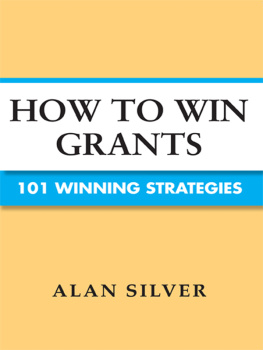


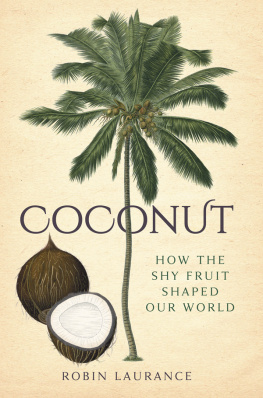
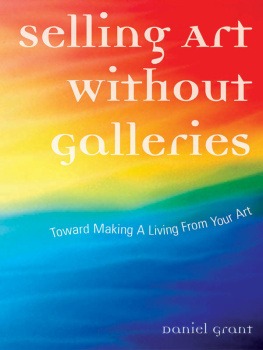
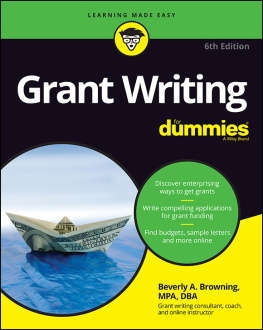
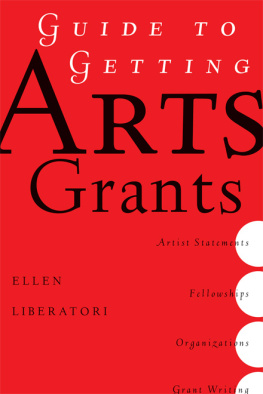

 Anita Pampusch, John Archabal, and Martha Lee at the Bush Foundation
Anita Pampusch, John Archabal, and Martha Lee at the Bush Foundation